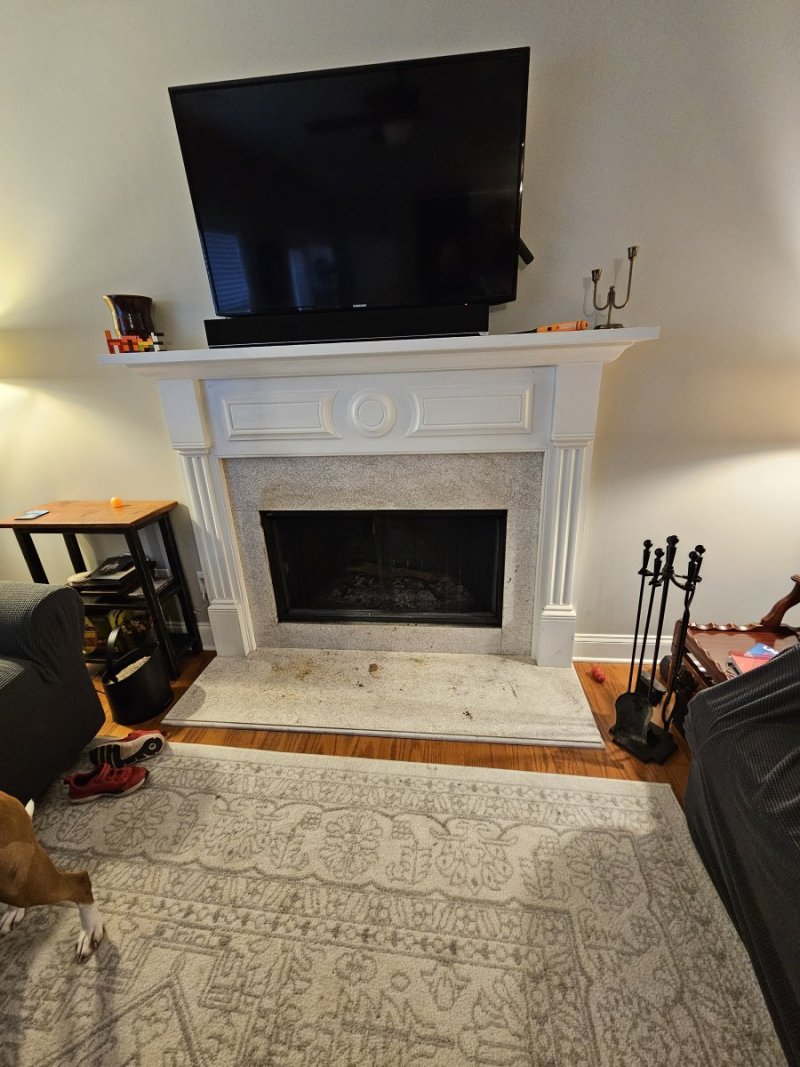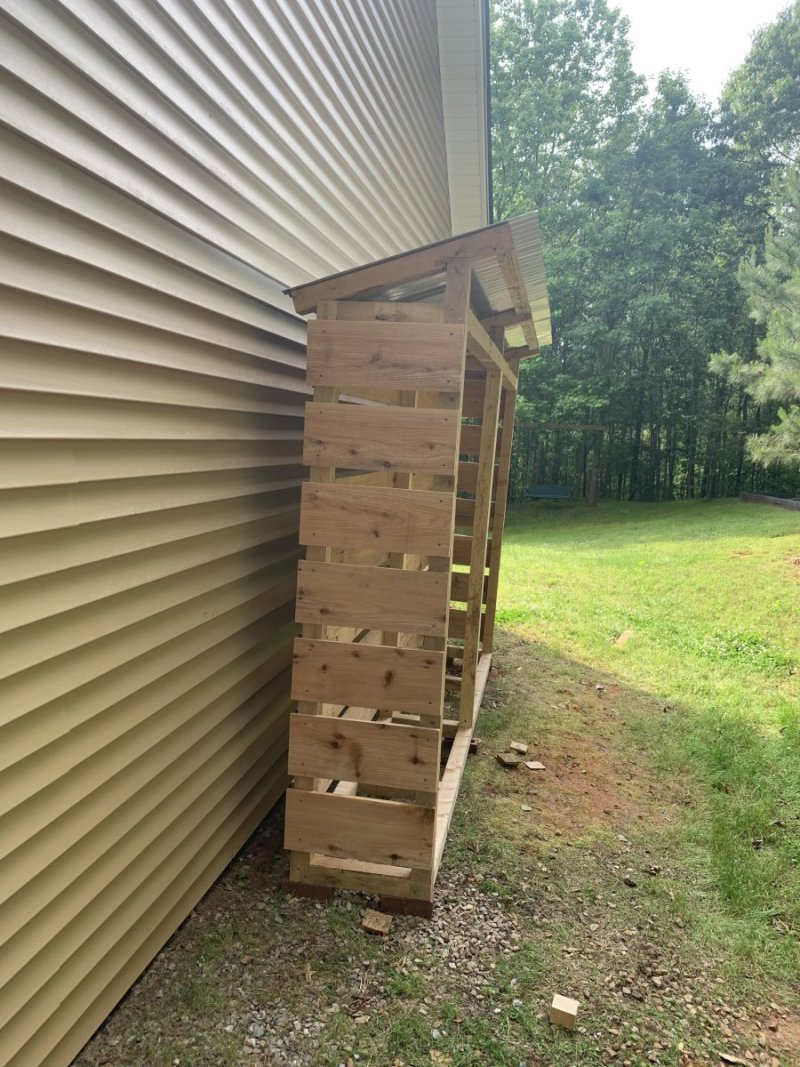Stay away from plywood and rolled shingles, unless you have a pretty good slope to the roof it will not last more than a couple years at best. 4x4s, 2x6s, and 1x4s and some metal for the roof. With that said I try and use sawmill lumber and get true size lumber and it holds up a lot better and the damn wood bees don’t mess with it either! They will chew pt lumber after the first year as well!
Navigation
Install the app
How to install the app on iOS
Follow along with the video below to see how to install our site as a web app on your home screen.
Note: This feature may not be available in some browsers.
More options
You are using an out of date browser. It may not display this or other websites correctly.
You should upgrade or use an alternative browser.
You should upgrade or use an alternative browser.
Somebody give me cheap shed roof ideas.
- Thread starter GeauxLSU
- Start date
Get roll of 30# felt. Lap each joint 3 to 4 inches and lift it up, fold the lap joint this way and thn back other way until you have made kind of a standing seal. Nail it at the standing seam with galvanized nails. Out in the middle where it might need nailing use those big headed shingle nails, kind thats mostly plastic. When you're done mop it with something like Kool Seal give it time to dry and second coat. Probably get 10 plus years from that.I'm way way overdue to build a cover for my tractor. (Just been going through tarps for years). For now (and perhaps always) it'll simply be an open 'carport' style cover. I intend to use PT lumber for the posts and cross members on the roof (no real trusses) and will simply be a flat sloping lean to style. Left to right.
Unfortunately discretionary funds are non existent at the moment (job hunt) but I do certainly have the time to get it done, so in order to justify this I need to figure out how to make this functional but as cheap as possible given the current cost of lumber. I'm not opposed to something temporary and then 'upgrade' the roof later.
The roof slope will be very slight and it will be adjacent to the back side of my cabin blocking the only window on that side.
I'm more concerned about water leaks when it comes to trashing the framing than I am it getting to/on the tractor.
Shed will be roughly 10' (or 12') x24'
So options are:
1. Plywood ($$$) and roll type asphalt roofing (due to low pitch/slope). Or perhaps there's a way to use some cheap 4x8 something or other and paint or treat it?(I do not want to use tin).
2. Clear corrugated plastic would be a big plus for light but I've never worked with it and question it's longevity and how water tight it would be?
3. Your idea.
- Joined
- Feb 7, 2013
- Messages
- 65,979
- Reaction score
- 74,126
I have almost the exact same size over my porch that I used plywood and rolled shingles and it's a VERY slight pitch. I guess it's been up 7 or so years at this point. So far so good. But yeah, the wood bees are wearing it out! Never got it stained. Another thing on the always growing list....Stay away from plywood and rolled shingles, unless you have a pretty good slope to the roof it will not last more than a couple years at best. 4x4s, 2x6s, and 1x4s and some metal for the roof. With that said I try and use sawmill lumber and get true size lumber and it holds up a lot better and the damn wood bees don’t mess with it either! They will chew pt lumber after the first year as well!

Stay away from plywood and rolled shingles, unless you have a pretty good slope to the roof it will not last more than a couple years at best. 4x4s, 2x6s, and 1x4s and some metal for the roof. With that said I try and use sawmill lumber and get true size lumber and it holds up a lot better and the damn wood bees don’t mess with it either! They will chew pt lumber after the first year as well!
This is the right way to do it right here. Forget the plywood roof.
A 2% grade in the old style landfill trenches (unlined back in the day) was the engineering standard to drain runoff away from the trench. As little as a 2% roof pitch will do the same thing.
- Joined
- Feb 7, 2013
- Messages
- 65,979
- Reaction score
- 74,126
Yes but the roll roofing is made specifically for low pitch roofs (which is what I used on the screened in porch). Having said that, this one will probably be roughly 1:10.A 2% grade in the old style landfill trenches (unlined back in the day) was the engineering standard to drain runoff away from the trench. As little as a 2% roof pitch will do the same thing.
I wish there was some type of plastic panels I could use. Only new stuff like that I can find is several times more expensive than wood. I guess it's going to be that clear corrugated stuff or roll roofing.
My friend did his newly-built shed roof first with rolled roofing,
but it leaked around the nail holes,
and
rain water rolled around the edges and came back to touch the wooden structure under the roofing material. He tore it off and then spent a couple hundred dollars buying real felt underlay and 3-tab shingles with a 20 year warranty.
But, even THAT leaked, too, within months and he attributes that to the very low pitch of the roof from the center down to the lowest and it was about a 10 foot span
and the drop was only about 6 inches.
Finally he covered the three tab shingles with several pieces of galvanized corrugated roofing metal he did not use nails to attach these because of his fear that water would leak around the nail holes instead he clamped them down around the perimeter of the shed building, and used a few cement blocks near the center to stabilize it this has successfully kept the water out of the building although it looks like hail and the cement blocks in the middle of the roof prevents pine needles and leaves from blowing off naturally. So it tends to collect organic material up there that periodically has to be scraped off or blown off by him climbing a ladder with a backpack blower!
BOTTOM LINE--- Give your roof a very substantial pitch.
The steeper the better -- I think 30° would be the minimum I would want.
but it leaked around the nail holes,
and
rain water rolled around the edges and came back to touch the wooden structure under the roofing material. He tore it off and then spent a couple hundred dollars buying real felt underlay and 3-tab shingles with a 20 year warranty.
But, even THAT leaked, too, within months and he attributes that to the very low pitch of the roof from the center down to the lowest and it was about a 10 foot span
and the drop was only about 6 inches.
Finally he covered the three tab shingles with several pieces of galvanized corrugated roofing metal he did not use nails to attach these because of his fear that water would leak around the nail holes instead he clamped them down around the perimeter of the shed building, and used a few cement blocks near the center to stabilize it this has successfully kept the water out of the building although it looks like hail and the cement blocks in the middle of the roof prevents pine needles and leaves from blowing off naturally. So it tends to collect organic material up there that periodically has to be scraped off or blown off by him climbing a ladder with a backpack blower!
BOTTOM LINE--- Give your roof a very substantial pitch.
The steeper the better -- I think 30° would be the minimum I would want.
while the pitch can and will be a determining factor in failure I'd be willing to bet improper installation was to blame for his leaks.My friend did his newly-built shed roof first with rolled roofing,
but it leaked around the nail holes,
and
rain water rolled around the edges and came back to touch the wooden structure under the roofing material. He tore it off and then spent a couple hundred dollars buying real felt underlay and 3-tab shingles with a 20 year warranty.
But, even THAT leaked, too, within months and he attributes that to the very low pitch of the roof from the center down to the lowest and it was about a 10 foot span
and the drop was only about 6 inches.
Finally he covered the three tab shingles with several pieces of galvanized corrugated roofing metal he did not use nails to attach these because of his fear that water would leak around the nail holes instead he clamped them down around the perimeter of the shed building, and used a few cement blocks near the center to stabilize it this has successfully kept the water out of the building although it looks like hail and the cement blocks in the middle of the roof prevents pine needles and leaves from blowing off naturally. So it tends to collect organic material up there that periodically has to be scraped off or blown off by him climbing a ladder with a backpack blower!
BOTTOM LINE--- Give your roof a very substantial pitch.
The steeper the better -- I think 30° would be the minimum I would want.
They have plastic 4x8 sheets at Home Depot designed for shower surrounds, smooth on one side, "pebbley" on the other. Don't know price, but they are used to divert water.
Pics?I have an old house at the front of my property, maybe 100 yrs old, foundation is large boulders and its still standing. Come tear it down and you can have all the free lumber and metal roof.
PS. Free ain’t easy, as my father in law says
I'd be in for that if he isn't.








